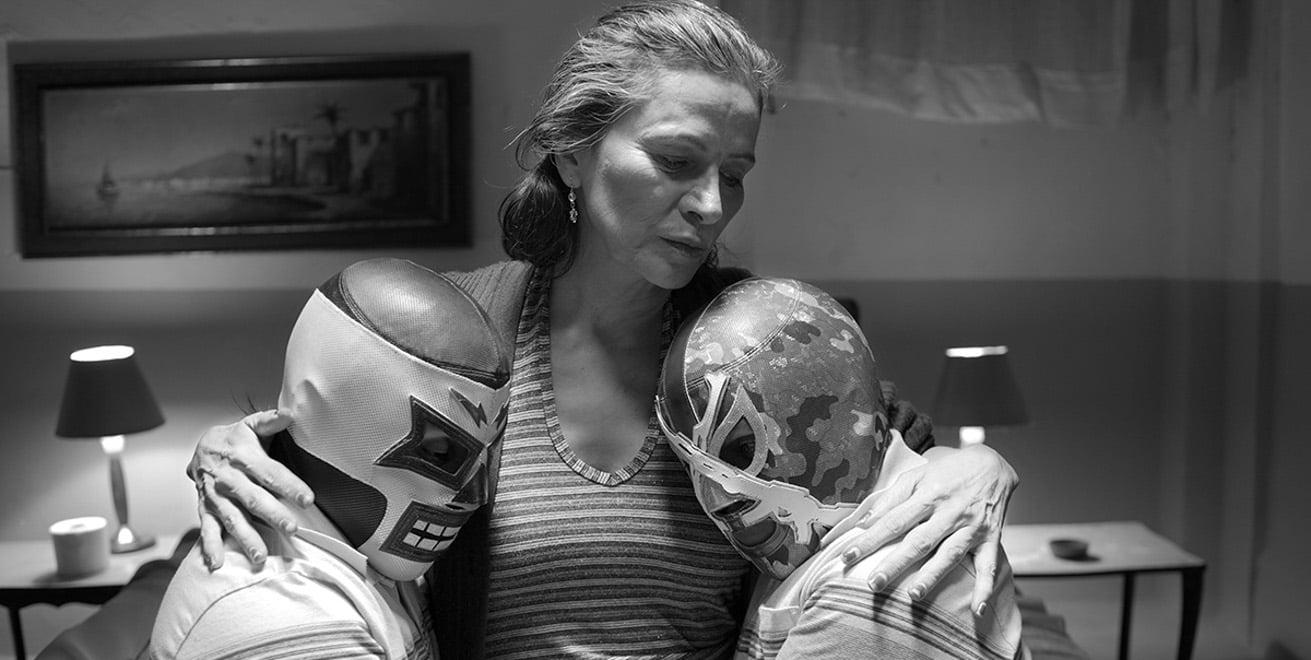Arturo Ripstein’s “Bleak Street” is a crude, black-and-black, unsentimental view of desperation and woe on Mexico’s Poverty Row. Despite what “Variety” or “The A.V. Club” might tell you, psychologically complex characters are not this film’s goal. It milks a mood (down-and-dirty Mexican backstreets) for all it’s worth, and for a higher purpose. This is fairy tale journalism drenched in mercury and sewage. It has the raggedness of a soiled comic book: used-up, forgotten, yet glinting with occasional hints of hushed-“a” artistry. The pop of Ripstein’s bas-relief stems from its unflinching commitment to portraying the muck of Mexico’s fallen and forgotten.
Ripstein (one of the key figures of New Mexican Cinema) bases this tawdry tale on a real crime involving two dwarf luchadores who were poisoned by two sex-workers in Mexico City in 2009. The sex workers are anonymous hustlers living day-to-day on the street. They decide they’ll rob their belittled clients by slipping some eye-drops in their drinks and taking their wallets while passed out. Unfortunately, they give the luchadores a lethal dose. Within days, the prostitutes are caught and arrested, their lives even more lost than before.
As a title, “Bleak Street” sounds too clipped and rhymes too perfectly to reflect this film’s strikingly imperfect visual poetics. The images are better fit to its original Spanish title “La Calle de la Amargura” (“The Street of Bitterness”). Everything is coated over with tar-molasses paint, giving the impression that it was shot from the depths of a robbed grave. Indeed, some scenes (a witness confessing in an underground jail cell) seem like outtakes shuttled in from Kurosawa’s existential thriller “High and Low” (1963). That, too, was a depressing tale about a scandalous crime (the kidnapping of a shoe exec’s chauffeur’s kid) where Kurosawa observed the astonishingly wide gap between Japan’s rich and poor.
However, Ripstein’s hipster pessimism differs from Kurosawa’s more hopeful contemplation. “La Calle de la Amargura” emits a shriller and more hateful Katzenjammer than Kurosawa’s pro-human bellowing. Both artists express the suffering they see in their respective country’s streets; it’s just more hellish in Ripstein’s version.
The camera’s inventive tricks can be easily mistaken for lousy filmmaking. Its teetering Steadicam glides suggest a vertigo-addled Ophuls or Demy. The sloppy shakiness shows us that nothing will ever be in aesthetic harmony on Ripstein’s Bitter Rue. “Bleak Street” moves in perpetual potential-energy mode, dragging its knuckles across muddy floors without feeling the need to hurry.
When the energy does become kinetic, however, the story, like Ophuls’ films (“Lola Montes,” “Madame De … ”), finds a lilting rhythm in languid long-takes where spontaneity and hope have been sucked out, vacuum-style (they’ve been replaced by freezing fatalism). The result? A visually crummy film about defeated wretches whose world, though seedy and corrupt, always has the upper hand.
Ripstein’s images are unabashedly grotesque and singular in meaning. The camera pans away from the action twice to perfectly-placed mirrors where, first, the two mini-luchadores bounce up and down on their motel deathbed and, later, a wife jerks off her husband. This is Morse Code imagination — exactly one idea per shot, usually extended beyond the point of initial understanding. Later, when one of the wrestler’s mothers finds out they’ve been killed, she breaks down in sloppy tears, shouting contrived lines that read ridiculously in English subtitles but sound fantastic in Mexican Spanish (credit is due to Ripstein’s long-time creative partner Paz Alicia Garciadiego, who wrote the screenplay). Taken together, this idea-per-shot simpleness and accurate-to-life dialogue enhance Ripstein’s lively, Expressionist portrayal of poverty.
“Bleak Street” opens Friday, March 11th at the Landmark Opera Plaza in San Francisco.
Contact Carlos Valladares at cvall96@ stanford.edu
